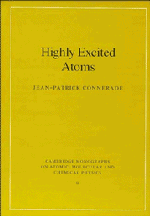Book contents
- Frontmatter
- Contents
- Preface
- 1 Closed shells, sphericity, stability and ‘magic numbers’
- 2 Rydberg states
- 3 Quantum defect theory for bound states
- 4 Atomic f values
- 5 Centrifugal barrier effects
- 6 Autoionisation
- 7 Inner-shell and double-excitation spectra
- 8 K-matrix theory of autoionising resonances
- 9 Atoms in strong laser fields
- 10 Statistical methods and ‘quantum chaology’
- 11 Atomic effects in solids
- 12 Atomic clusters
- References
- Index
4 - Atomic f values
Published online by Cambridge University Press: 19 September 2009
- Frontmatter
- Contents
- Preface
- 1 Closed shells, sphericity, stability and ‘magic numbers’
- 2 Rydberg states
- 3 Quantum defect theory for bound states
- 4 Atomic f values
- 5 Centrifugal barrier effects
- 6 Autoionisation
- 7 Inner-shell and double-excitation spectra
- 8 K-matrix theory of autoionising resonances
- 9 Atoms in strong laser fields
- 10 Statistical methods and ‘quantum chaology’
- 11 Atomic effects in solids
- 12 Atomic clusters
- References
- Index
Summary
Line strengths of discrete transitions
In the present chapter, we consider line strengths of transitions between bound states, i.e. of lines whose only form of natural broadening is radiative, and which lie below the first ionisation potential. The simplest situation is encountered in the photoabsorption or photoexcitation of an atom, initially in its ground state | i ≥, in which case one transition is observed to each excited final state | f ≥. The price one pays for this simplicity is that all excited states cannot be reached in this way because of selection rules.
The distribution of intensities is an essential property of a spectrum. We may consider: (a) the distribution in energy over the whole spectrum; or (b) the distribution within an individual spectral line.
It was noted in the previous chapter that spectral lines of interacting channels can differ greatly in intensity within a narrow energy range. However, with some significant exceptions, if one can approach the series limit closely enough to be clear of perturbers, the intensities of successive members decrease monotonically with increasing principal quantum number n. This is described as the normal course of intensity for a Rydberg series.
In the presence of perturbations, the course of intensities becomes far less regular than that of transition energies, and it is generally more likely that intensities will exhibit fluctuations or departures from the expected behaviour.
- Type
- Chapter
- Information
- Highly Excited Atoms , pp. 97 - 131Publisher: Cambridge University PressPrint publication year: 1998



